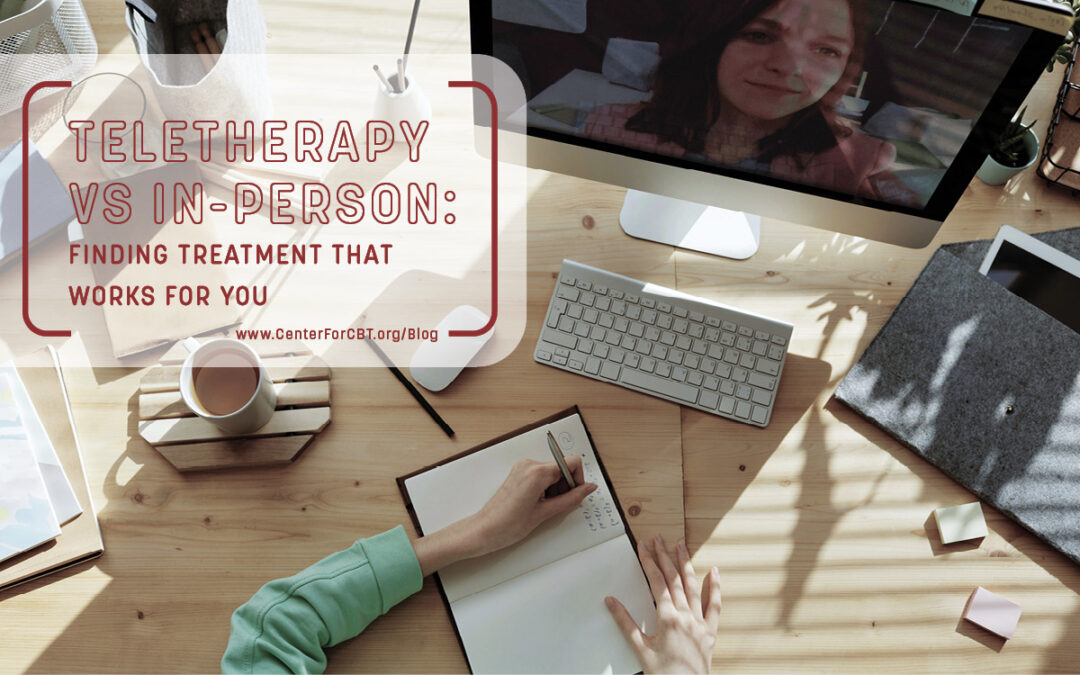There is no doubt that telehealth has made therapy more accessible for many communities, particularly those who are immunocompromised or movement impaired. However, some people still have their reservations about how effective it really is. Studies have shown that telehealth is equally effective when compared to in-person services in a range of modalities. That being said, there are benefits to both virtual and in-person therapy, and a number of more nuanced factors that one might consider in relation to their lifestyle and goals for treatment.
Benefits of Teletherapy
Teletherapy can accommodate the needs that arise in a variety of therapeutic situations. Whether you are seeking services for yourself or for your child, it’s important to weigh the options available to you to determine what will be most helpful for you and your family. When it comes to virtual sessions, you might consider these benefits:
- Scheduling Flexibility. More appointment slots will be available to you when you don’t have to factor in travel time. Your clinician’s office may be able to see you sooner if your schedule is more flexible. Afternoon and evening slots are often in high demand, so virtual sessions could allow you to more easily accommodate an appointment in the morning, or during a lunch or study break.
- Reduced Travel. Attending virtual sessions allows you to spend more time on the other important things in your life, instead of dealing with the hassles that come with commuting or corralling children into the car. This is also a great advantage if you’re ever without transportation and find you are unable to make it into your clinician’s office.
- Increased Options. Teletherapy also makes care more accessible for those who are traveling or live out of state, thanks to PSYPACT. There are only two requirements: your clinician must be enrolled in the program, and you must be located in one of the participating states. This ultimately affords you the opportunity to work with quality providers who are not local to you.
- Reduced Anxiety. Attending in-person appointments can be nerve wracking for some people, especially if they are new to therapy. Joining a session from the comfort of your own home eliminates the anxiety that may be associated with navigating to a new location or sitting in a waiting room. It also offers flexibility to match your comfort level, with options to join using only the voice feature for situations in which you prefer not to be on video.
Teletherapy is also especially useful when treating behavioral challenges in younger children. Your clinician will have the opportunity to observe your child interact with others in the home, help you navigate tantrums, and offer specific instructions to mitigate challenging behaviors. When your clinician has the benefit of observing how issues play out in real time within the home environment, it allows them to offer more pertinent advice and work with you to develop effective parenting strategies that help you and your family in the long run.
Benefits of In-Person Therapy
While there are many compelling advantages to teletherapy, there are still elements of in-person therapy that individuals and families may prefer. As convenient as virtual sessions can be, it can at times have its shortcomings and a face-to-face connection may feel more personable (at least for the first few sessions). While teletherapy also improves accessibility of care in most situations, it is not necessarily the best choice for those without a steady and reliable internet connection. Technological issues can impede the effectiveness of treatment and should be assessed prior to beginning virtual sessions. Depending on the challenges you are looking to address in therapy, some treatments remain more effective when conducted in-person. This may be particularly true for young children who are easily distracted and unable to focus during a virtual session. Traveling to your clinician’s office for regular sessions can also help with routine building, but that isn’t necessary for everyone. It is important to follow your clinician’s expert advice so that you can be confident your sessions are going to match your treatment needs.
Deciding What is Right for You
While personal preference and the practicality of care access come into play when deciding what therapy format is right for you, it is worth considering starting sessions virtually if your clinician’s office does not have in-person availability. There is also a negligible difference in terms of cost and coverage, at least in New Jersey, thanks to recent legislation. Ultimately, having teletherapy is more helpful than having no therapy in most cases. In tandem with your session format, there are three key factors which will have a significant bearing on the effectiveness of therapy:
- Finding the right treatment. The primary challenges you are looking to address will influence the type of therapy that is right for you. Modalities like CBT and DBT have a more structured format than talk therapy, and are recommended for a goal-oriented and skill building approach. It is also important to seek evidence-based treatments to ensure you are receiving comprehensive, quality care.
- Building a rapport. In addition to working with someone who specializes in the type of treatment you need, the connection you share with your therapist is critical to the success of your therapy. You want to find someone who you respect, and who respects you. Working with someone who you feel understands you, values your perspectives, and gently challenges you makes all the difference.
- Your willingness to grow. You can only get as much out of therapy as you put in. Therapy is not a fast or easy journey, and its success relies on your commitment to self-improvement. The desire to grow as an individual, learn new skills, and adjust your ways of thinking must all be practiced to improve your quality of life.
Determining if in-person or teletherapy sessions are right for you is an important part of developing an effective mental health care regimen. This, in harmony with the type of treatment, clinician, and your commitment, are all integral to the success of your care. Finding the right approach to therapy can be a time-consuming process, but being careful in your considerations is well worth the effort.


